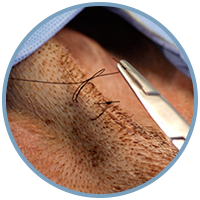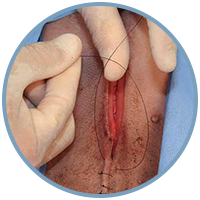Instrument versus Hand Tie?
Surgical knots can be tied using a surgical instrument or manually (known as a hand tie). When to choose a hand tie over an instrument tie depends upon the circumstances. In this topic, you will learn about the advantages and disadvantages of instrument and hand ties and about some common surgical applications for each technique.
Instrument Ties

![]()
Pros:
- Rapid placement of sutures
- Conserves suture material
- Does not require long strands for tying
![]()
Cons:
- Free strand is not controlled during knotting
- Difficult to maintain consistent tension
![]()
Applications:
- Closing wounds under minimal tension
- Microsurgical procedures
- Deep recesses with small approaches
- General soft tissue approximation
When tying knots with an instrument, it is difficult to control the strands during tying. The non-fixed or working end lies free between the creation of the throws, and, therefore, it is not controlled at all times. Because of this, it is tough to apply continuous tension to the suture ends as you knot tie. Consequently, widening or loosening of the suture loop due to slippage is frequently encountered during instrument tying in wounds subjected to strong tension.
The instrument technique, however, is ideally suited for closing a wound that is subjected to minimal tension. In this circumstance, instrument ties can usually be accomplished more rapidly than hand ties, while conserving considerably more suture. By using instruments instead of hands, the thrifty surgeon can complete 10 or more interrupted knotted stitches using one suture strand measuring 18 inches (45 cm) in length (standard suture length). This feat would be impossible if the knots had been tied by hand, where a surgeon would be lucky to achieve 3 or 4 hand ties with this length of suture.
The value of instrument ties is readily apparent in special situations in which hand ties are impractical or impossible. In microsurgical procedures, an instrument tie provides the most reliable and easiest method of knot construction. Instruments are also useful for forming knots in tight spaces such as deep in the mouth, in the rectum or vagina, or in endoscopic surgery.
Hand Ties

![]()
Pros:
- Suture strands are always controlled
- Offers good control (sense) of suture tension
![]()
Cons:
- Requires ample suture material
![]()
Applications:
- Pre-placement sutures
- Deep recessed with large approaches
Manual knot ties also have their advantages and disadvantages. Tying knots by hand allows the surgeon to "feel" how much intrinsic suture tension has been achieved. It also allows a better gauge of the tension applied on both strands during tying. Hand ties are particularly useful when the knot is pushed (i.e., "run down" with a deep tie technique) in confined or hard to reach areas, such as in a dorsal diaphragmatic hernia.
Hand ties are also useful when sutures have been preplaced. For example, individual sutures are often preplaced around the ribs in a lateral thoracotomy approach and are tagged or clamped with hemostats without tying until the series of sutures are placed along the entire length of the opened intercostal space. While the assistant crosses adjacent preplaced sutures to help draw the ribs in apposition, the surgeon can then hand knot tie more easily.
Hand ties are also useful when working in remote areas, such as deep in body cavities. Sometimes it is difficult to manipulate instruments in remote areas, and hand throws can be created in more superficial areas of the wound first, and then the throw can be pushed ("run down") and tightened down more easily using the fingertips.
Despite the many advantages of hand ties, keep in mind that they do require more length of suture strands than instrument ties. Additionally, the longer ends have to be cut off once the hand tie is completed, which wastes suture material.
